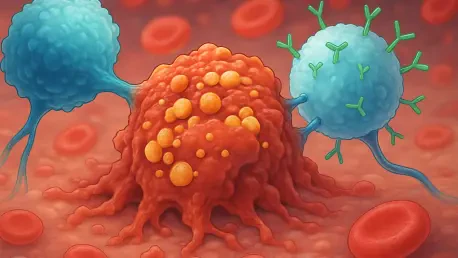What if a silent, often-ignored component of human cells could hold the key to revolutionizing cancer treatment and transform the way we approach deadly diseases? Lipids, the fatty molecules typically associated with cell structure, have emerged as unexpected warriors in the fight against cancer. A groundbreaking discovery from a leading research institution has revealed that a specific lipid, phosphatidylserine, can trigger a powerful immune response, potentially transforming how therapies target deadly tumors. This finding challenges long-held assumptions about immune activation and opens a thrilling new chapter in oncology.
The Surprising Signal Behind Cancer-Fighting Immunity
The notion that lipids could play a starring role in battling cancer might seem far-fetched at first glance. Yet, recent research has uncovered that these molecules are not just passive bystanders but active players in a critical immune process known as LC3-associated phagocytosis (LAP). This mechanism helps the body clear out dead cells and pathogens while keeping inflammation in check—vital functions when dealing with cancer’s chaotic growth. The spotlight falls on phosphatidylserine, a lipid that shifts position during cellular threats, acting as a beacon for immune action.
This discovery carries immense weight in a world where cancer remains a top cause of mortality, claiming millions of lives each year. With traditional treatments often falling short against aggressive tumors, the identification of lipid-driven immunity offers a fresh angle. It suggests that manipulating something as fundamental as a cell’s lipid composition could unlock stronger, more precise defenses against malignancy, paving the way for therapies that work smarter, not just harder.
Why Lipids Are the Unsung Heroes of Cancer Therapy
Lipids have long been viewed as mere building blocks of cell membranes, overshadowed by proteins and genes in medical research. However, their role extends far beyond structure—they are dynamic messengers in immune signaling. In the context of cancer, where tumors often suppress immune responses to thrive, understanding lipid interactions could be a game-changer. The ability of lipids to influence processes like LAP provides a new lens through which to view tumor environments.
The significance of this cannot be overstated. Cancer’s ability to evade the immune system often renders even advanced treatments ineffective. By focusing on how lipids regulate immune clearance and inflammation, scientists are beginning to see a path toward disrupting this evasion. This shift in perspective elevates lipids from background players to potential targets for cutting-edge interventions, promising a future where immune responses are fine-tuned to outsmart cancer’s defenses.
Decoding Lipid-Driven Immune Activation
At the heart of this breakthrough lies a detailed understanding of how phosphatidylserine orchestrates LAP. Under normal conditions, this lipid resides on the inner side of cell membranes, hidden from view. But when cells encounter threats—be it dead tissue, microbes, or other dangers—phosphatidylserine becomes enriched on the phagosome membrane, a structure involved in engulfing harmful particles. This relocation sends a clear signal, marking the target for immune processing.
This signal doesn’t stop there. The enriched lipid acts as a docking site, recruiting a specific protein complex called the Rubicon-containing PI3-kinase. This interaction sparks an enzymatic chain reaction essential for LAP activation, ensuring the threat is degraded efficiently. What’s remarkable is that this lipid-based mechanism responds uniformly to diverse stimuli, whether it’s a dying cell or an antibody-coated particle, revealing a universal language of cellular defense.
The implications for cancer are profound. Earlier studies have shown that inhibiting LAP in certain tumor settings can enhance anticancer immunity, suggesting that tweaking lipid signals could tip the balance against malignancy. This molecular insight, backed by rigorous lab work, underscores how a seemingly minor component like a lipid can wield major influence over life-and-death processes within the body.
Voices from the Frontier of Immunology
The excitement surrounding this discovery is palpable among those at the forefront of immunology. Doug Green, PhD, a leading figure in the field, describes the finding as a pivotal moment, stating, “Understanding how lipids drive LAP gives us a concrete starting point to manipulate immune responses in diseases like cancer.” His words reflect a shared optimism that this research could redefine therapeutic strategies over the coming years, from 2025 onward.
Equally striking is the reaction of Emilio Boada-Romero, PhD, a key researcher on the project, who admits to being stunned by the results. “The idea that a lipid could function as a critical site for protein interactions was beyond our expectations,” he notes. These expert perspectives, supported by funding from esteemed organizations like the U.S. National Institutes of Health, lend significant credibility to the work, highlighting its potential to reshape scientific understanding of immune regulation at the cellular level.
Their insights also point to broader questions about membrane dynamics and how other lipids might contribute to immunity. This curiosity drives the field forward, encouraging a deeper exploration of cellular components once dismissed as insignificant. The consensus is clear: lipids are no longer just part of the background—they are active agents in the body’s fight against disease.
Turning Lipid Insights into Cancer Treatments
With lipids now recognized as central to immune activation, the focus shifts to practical applications in cancer care. One promising avenue involves boosting phosphatidylserine levels on phagosome membranes within tumor areas. Such an approach could amplify LAP activity, helping to clear cancer debris and ignite stronger immune responses, potentially shrinking tumors more effectively than current methods.
Another strategy builds on past findings that blocking LAP in specific contexts can counteract tumor-induced immune suppression. Developing drugs to selectively inhibit this process might allow natural defenses to attack cancer cells unhindered. Additionally, combining lipid-targeted therapies with existing treatments like immunotherapy or chemotherapy could create powerful synergies, enhancing overall impact.
Looking ahead, personalized medicine could benefit immensely from this research. Imagine diagnostics that analyze a patient’s lipid profile to customize treatments, optimizing LAP activation for individual immune systems. These innovative approaches, grounded in molecular discoveries, offer a roadmap for translating lab findings into tangible benefits, bringing hope to countless patients battling cancer across the globe.
Reflecting on a Lipid-Powered Breakthrough
Looking back, the revelation that lipids like phosphatidylserine could trigger vital immune responses marked a turning point in cancer research. This unexpected discovery illuminated a hidden mechanism within cells, showing how even the smallest components could wield enormous influence over disease outcomes. It shifted the narrative, placing lipids at the center of a new wave of therapeutic possibilities.
The next steps were clear even then. Researchers needed to dive deeper, testing lipid-modulating drugs in clinical trials to confirm their efficacy against tumors. Collaboration between scientists and clinicians became essential to refine these strategies, ensuring they reached patients swiftly. The focus also turned toward educating the medical community about lipid signaling, fostering a broader understanding of its potential.
Beyond immediate applications, this breakthrough inspired a reevaluation of other cellular players, encouraging a holistic approach to immunity. The journey ahead promised challenges, but also immense rewards—perhaps even a future where cancer’s grip on humanity was significantly weakened by harnessing the subtle power of lipids.









